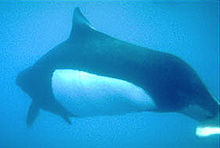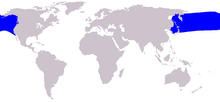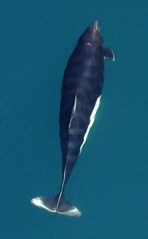Dall's porpoise
| Dall's porpoise[1] | |
|---|---|

| |

| |
| Size compared to an average human | |
| Scientific classification | |
| Kingdom: | |
| Phylum: | |
| Class: | |
| Order: | |
| Suborder: | |
| Family: | |
| Genus: | Phocoenoides Andrews, 1911
|
| Species: | P. dalli
|
| Binomial name | |
| Phocoenoides dalli (True, 1885)
| |

| |
| Dall's porpoise range | |
Dall's porpoise (Phocoenoides dalli) is a species of porpoise found only in the North Pacific. It came to worldwide attention in the 1970s when it was disclosed for the first time to the public that salmon fishing trawls were killing thousands of Dall's porpoises and other cetaceans each year by accidentally capturing them in their nets. Dall's porpoise is the only member of the genus Phocoenoides. It was named after American naturalist W. H. Dall.
Description

The unique body shape of Dall's porpoise makes it easily distinguishable from other cetacean species. The animal has a very thick body and a small head. The colouration is rather like that of a killer whale; the main body of the porpoise is very dark grey to black, with very demarcated white patches on the flank and belly. The dorsal fin is set just back from the middle of the back and sits up erect. The upper part of the dorsal fin has a white to light grey "frosting".
The fluke has a similar frosting. The adult fluke curves back towards the body of the animal, which is another distinguishing feature. It is larger than other porpoises, growing up to 2.3 m (7.5 ft) in length and weighing between 130 and 220 kg (290 and 490 lb).[3] There is also sexual dimorphism in the species, with males being larger, having a deeper caudal peduncle and a pronounced hump behind the anus.[3] Young Dall's have a greyish tint and dark-colored flukes.
Population and distribution

Dall’s porpoise ranges through much of the North Pacific and nearby seas, such as the Bering and Okhotsk Seas and the Sea of Japan. The southernmost part of its range is southern Japan in the west and southern California in the east, while it is northernmost range is the central Bering Sea.[4] They do enter Scammon's Lagoon in Baja California, though, when the waters are unseasonably cold.[5] They also travel up to the Chukchi Sea, though very rarely.[4]
Dall’s porpoise prefers cold waters more than 180 metres (590 ft) deep.[3] It is found over the continental shelf adjacent to the slopes and oceanic waters.[6] While it mostly lives in offshore waters, it does occur in deep coastal waters on off North America.[4] There, it typically stays close to deep-water canyons.
Two consistent and well-defined colour morphs, the dalli-type and the truei-type, have been identified. The dalli-type is present throughout the porpoise’s range, while the truei-type lives mostly on the western Pacific and is rare in the east.[3] There is some question as to whether the morphs are merely colour patterns (the truei-type having a more extensive belly patch) or whether they are separate subspecies.[5][7] They are believed to number around 104,000 off Japan, 554,000 in the Okhotsk Sea, 83,000 off Alaska and 100,000 off the continental US.[4]
Ecology and lifestyle

Dall’s porpoises primarily eat small fishes (of numerous species) and cephalopods.[4] Schooling fish, such as herrings, anchovies, pilchards, mackerels, hake and sauries[3][4] are favored prey, as well as mesopelagic fish such as myctophids and deep sea smelts.[4] They may also consume krill, but these are probably not important in their diet.[4] Dall’s porpoise are deep divers. They have been recorded to dive to 94m.[8] Dall’s porpoise are prey to killer whales and white sharks. However, Saulitis et al. (2000) described non-aggressive interactions between killer whales and Dall's porpoises in Prince William Sound, as "Dall’s porpoises were observed swimming with resident killer whales, engaging in apparent play behaviors with killer whale calves, and surfacing rapidly just in front of killer whales, sometimes making physical contact...One recognizable Dall’s porpoise remained with the AB resident pod from May through September in 1984".[9] They also are susceptible to certain parasites. The trematode fluke Nastitrema, an internal parasite, is known to cause death and stranding of the porpoises.[4] External parasites of the porpoise are whale lice.

Dall's porpoises are highly active creatures. They will often zigzag around at great speed on or just below the water surface, creating a spray called a "rooster tail". They may appear and disappear quite suddenly. The fastest of all small cetaceans, Dall's porpoises can swim at up to 55 km/h, almost as fast as the killer whale. The porpoises will approach boats and will bow- and stern-ride, but may lose interest, unless the boat is travelling quickly. They will also "snout ride" on waves made by the heads of large whales.[4] They may also do more calm behaviors, such as subdued rolls at the surface.[4] They rarely leap from the water.[4] Dall's Porpoises have never been observed to sleep.[10]
Dall’s porpoises live in small, fluid groups of two to 12.[3] However they can gather in the hundreds when feeding.[3] They have a polygynous mating system in which males will guard females in estrus.[11] During the mating season, a male will select a fertile female and guard her to ensure that he will sire her calf.[11] While guarding, males may sacrifice opportunities to forage in deep dives.[11] Births usually take place in the summer.[4] Porpoise gestation lasts 10 to 11 months, and the lactation period lasts at least two months.[3] Depending on their condition, females can give birth up to every year.[3] Dall's porpoises live for up to 22 years.[12]

One study[13] determined through DNA sequencing that a fetus found in British Columbia was an intergeneric hybrid of a Dall's porpoise and a harbour porpoise. This hybrid may not be rare— it may describe the origins of some atypically coloured individuals that otherwise appear to be Dall's porpoises spotted off the coast of Vancouver Island.
Conservation status
Many Dall's porpoises are killed each year as by-catch in fishing nets.[citation needed] A serious cause of concern is the hunting of the species by harpoon by Japanese hunters.[citation needed] The number of porpoise caught each year rose dramatically following the moratorium on hunting larger cetaceans introduced in the mid-1980s. The greatest number were caught in 1988, when more than 40,000 were taken. International attention to the hunt through a 1990 International Whaling Commission (IWC) resolution resulted in a reduction in numbers caught; however, around 15,000 animals are still caught each year, making it the largest direct hunt of any cetacean species in the world. The hunt has been repeatedly criticized by the IWC and its Scientific Committee, most recently in 2008.[14] A quota of just over 16,000 individuals per year is now in effect. In addition, unknown numbers of animals are struck and lost or caught as by catch. Despite these threats, Dall's porpoise remains a fairly common species with productive populations.
Dall's porpoise is listed on Appendix II[15] of the Convention on the Conservation of Migratory Species of Wild Animals (CMS). It is listed on Appendix II[15] as it has an unfavorable conservation status or would benefit significantly from international co-operation organized by tailored agreements.
See also
References
- ^ Mead, J. G.; Brownell, R. L. Jr. (2005). "Order Cetacea". In Wilson, D. E.; Reeder, D. M. (eds.). Mammal Species of the World: A Taxonomic and Geographic Reference (3rd ed.). Johns Hopkins University Press. pp. 723–743. ISBN 978-0-8018-8221-0. OCLC 62265494.
- ^ Template:IUCN2008Database entry includes a lengthy justification of why this species is of Least Concern
- ^ a b c d e f g h i Randall R. Reeves; Brent S. Stewart; Phillip J. Clapham; James A. Powell (2002). National Audubon Society Guide to Marine Mammals of the World. Alfred A. Knopf, Inc. ISBN 0-375-41141-0.
- ^ a b c d e f g h i j k l m Thomas A. Jefferson. "Dall's porpoise Phocoenoides dalli" pp. 296-298 of Encyclopedia of Marine Mammals (edited by William F. Perrin, Bernd Wursig, and J. G.M. Thewissen), Academic Press; 2nd edition, (2008).
- ^ a b Morejohn, GV (1979). The natural history of Dall's porpoise in the North Pacific Ocean. In "Behavior of Marine Animals", Vol. 3, "Cetaceans" (Eds HE Winn and BL Olla) pp. 45-83. Plenum Press, New York
- ^ Hall, J. 1979. A survey of cetaceans of Prince William Sound and adjacent waters - their numbers and seasonal movements. Unpubl. rep. to Alaska Outer Continental Shelf Environmental Assessment Programs. NOAA OCSEAP Juneau Project Office, Juneau, AK. 37 pp.
- ^ S. Escorza-Treviño, L. A. Pastene and A. E. Dizon. (2004). "Molecular Analyses of the Truei and Dalli Morphotypes of Dall's Porpoise (Phocoenoides dalli)", Journal of Mammalogy, 85(2): 347-355.
- ^ Hanson, M.B., and R.W. Baird. 1998. "Dall’s porpoise reactions to tagging attempts using a remotely-deployed suction-cup attached tag". Marine Technology Society Journal 32(2):18-23.
- ^ Saulitis, E., Matkin, C., Barrett‐Lennard, L., Heise, K., & Ellis, G. (2000). Foraging strategies of sympatric killer whale (Orcinus orca) populations in Prince William Sound, Alaska. Marine Mammal Science, 16(1), 94-109.
- ^ Ridgway, S.H.; Harrison, R.J. (1999). Handbook of Marine Mammals: The Second Book of Dolphins and the Porpoises. Academic Press. p. 452. ISBN 9780125885065.
- ^ a b c Willis P. M., Dill L. M. (2007). "Mate Guarding in Male Dall's Porpoises (Phocoenoides dalli)". Ethology 113(6): 587-597.
- ^ "Dall's Porpoise - Phocoenoides Dalli". United States National Park Service.
- ^ *An intergenetic breed in the family Phocoenoidae, Canadian Journal of Zoology, Baird, Willis, Guenther, Wilson and White 1998. Vol 76 pages 198-204.
- ^ "Report of the Sub-Committee on Small Cetaceans" (PDF). 7.6: International Whaling Commission. June 2008. p. 10. Retrieved 1 March 2010.
{{cite web}}: CS1 maint: location (link) - ^ a b "Appendix II" of the Convention on the Conservation of Migratory Species of Wild Animals (CMS). As amended by the Conference of the Parties in 1985, 1988, 1991, 1994, 1997, 1999, 2002, 2005 and 2008. Effective: 5 March 2009.
External links
- www.dallsporpoise.org
- Whale & Dolphin Conservation Society (WDCS)
- EIA cetacean campaign:Reports on dall's porpoise catches.
- EIA in the USA: reports & news.
- Convention on Migratory Species page on the Dall's porpoise
- Voices in the Sea - Sounds of the Dall's Porpoise

